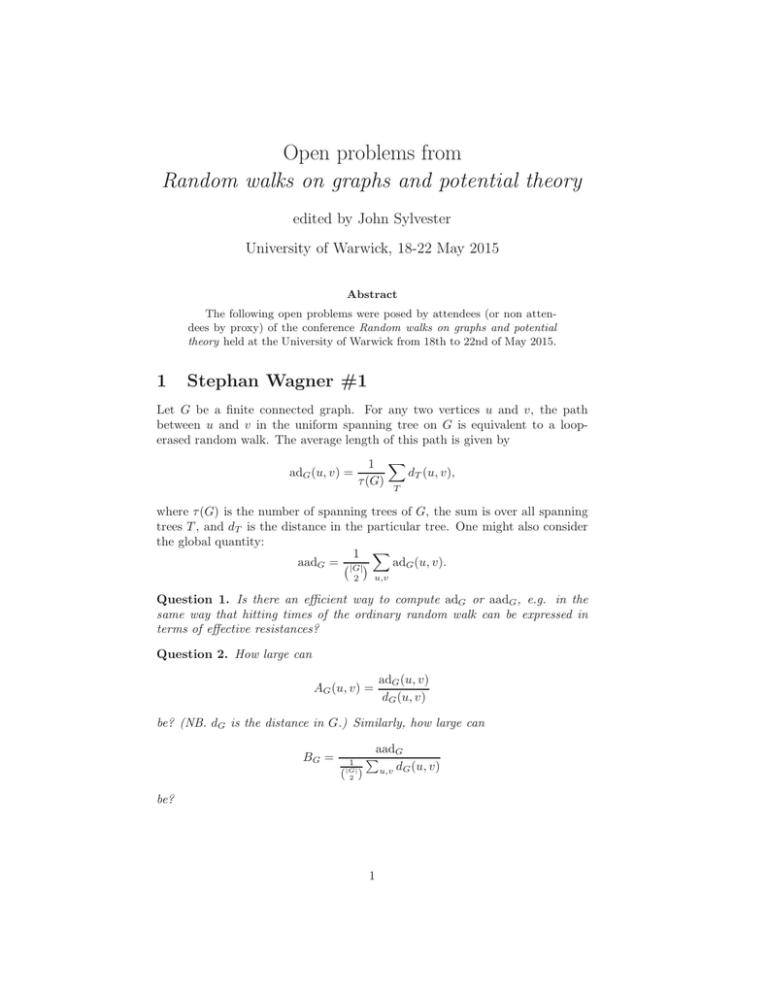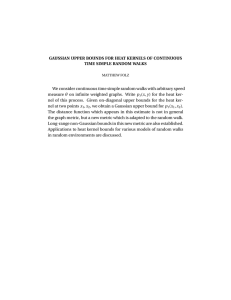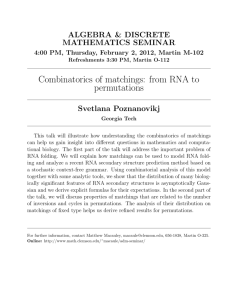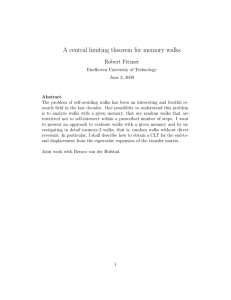Open problems from Random walks on graphs and potential theory
advertisement

Open problems from
Random walks on graphs and potential theory
edited by John Sylvester
University of Warwick, 18-22 May 2015
Abstract
The following open problems were posed by attendees (or non attendees by proxy) of the conference Random walks on graphs and potential
theory held at the University of Warwick from 18th to 22nd of May 2015.
1
Stephan Wagner #1
Let G be a finite connected graph. For any two vertices u and v, the path
between u and v in the uniform spanning tree on G is equivalent to a looperased random walk. The average length of this path is given by
1 X
dT (u, v),
τ (G)
adG (u, v) =
T
where τ (G) is the number of spanning trees of G, the sum is over all spanning
trees T , and dT is the distance in the particular tree. One might also consider
the global quantity:
1 X
aadG = |G|
adG (u, v).
u,v
2
Question 1. Is there an efficient way to compute adG or aadG , e.g. in the
same way that hitting times of the ordinary random walk can be expressed in
terms of effective resistances?
Question 2. How large can
AG (u, v) =
adG (u, v)
dG (u, v)
be? (NB. dG is the distance in G.) Similarly, how large can
BG =
1
|G|
2
( )
aadG
P
u,v dG (u, v)
be?
1
It is trivial that both AG (u, v) and BG are equal to 1 if G
pis a tree itself.
Moreover, if G is the complete
graph,
one
has
that
B
=
Θ(
|G|). SW conG
p
jectured that BG = O( |G|)
for
any
graph,
but
also
gave
an
example
demonp
the example given by SW, it was noted
strating that AG (u, v) 6= O( |G|). (For p
by Ori Gurel-Gurevich that AG = Θ( |E|).) However, this was disproved
by Endre Csóka during the workshop, who described a construction that gives
BG ≥ |G|3/4−ǫ . Is this best possible?
2
Stephan Wagner #2
If (λi )ni=1 are the eigenvalues of the Laplacian on a finite weighted graph, then
it is known that
n
X
1
1 X
r(u, v),
=
λ
n
i=2 i
{u,v}⊂V
where r(u, v) is the resistance between u and v. (The right-hand side here is
sometimes referred to as the Kirchhoff index of the graph.) For example, if the
graph is a tree, then
n
X
1 X
1
dT (u, v),
=
λ
n
i=2 i
{u,v}⊂V
where dT is the weighted graph distance. In the continuous setting, consider
the Sturm-Liouville problem on [0, 1],
(f u′ )′ + λu′ = 0,
with boundary conditions u′ (0) = u′ (1) = 0. The corresponding eigenvalues
satisfy
X 1 Z 1 x(1 − x)
=
dx.
(1)
λ
f (x)
0
λ6=0
Question 3. Is there a general theory that explains the latter result?
Ben Hambly gave a proof of (1) making use of the heat kernel that seems to
generalise to quantum graphs and possibly also domains in Rd .
3
Omer Angel
First, let M1 := (Z, E1 ) , M2 := (Z, E2 ) be independent, translation invariant
matchings of Z (these might have the same or different distributions). Then
take the graph which is the union of the two matchings,
G = (Z, E1 ∪ E2 ) ,
and define N to be the number of infinite paths in G.
Question 4. Is it possible that
P (N = 1) = 1?
2
Example. If we select M1 , M2 uniformly from the set of non-crossing matchings, then N ∈ {0, 1} almost-surely.
Conjecture 1. In the setting of the previous example, N = 0 almost-surely.
Example. If M1 , M2 are selected uniformly from (the two possible) nearest
neighbour matchings, then
P (N = 0) =
1
,
2
P (N = 1) =
1
.
2
Example. Consider site percolation on the hexagonal lattice (i.e. cells coloured
independently green and yellow with probabilities p and 1−p respectively). Moreover, assume the boundary condition along the horizontal axis is that the cells
alternate green and yellow. The percolation interfaces in the upper and lower
half plane then generate independent matchings of Z. At criticality, p = 1/2, it
holds that N = 0 almost-surely.
4
Itai Benjamini (in absentia by proxy of Omer
Angel)
Take some locally finite initial configuration of points on the real line and define
some potential F (x, y) to be the force between two points x, y, for example
−2
F (x, y) := |x − y|
.
Letting (an )n∈Z be the positions of the points, we say that the system is said
to be in equilibrium if
X
F (ai , an )sgn(ai − an ) = 0,
∀n.
i6=n
For a sequence (an )n∈Z in arithmetic progression the total force is 0, this motivates the following question:
Question 5. If (an )n∈Z is in equilibrium, is
an = αn + β
for all n and some α, β ∈ R?
5
Antoine Gournay
Take Γ to be a transient Cayley graph of some group G, and P to be the
transition operator of a simple random walk on Γ. Define the green kernel of P
to be
X
G(x, y) :=
Pxm (y).
m≥0
Pxm (y)
where
is the probability to get to y in m steps when starting from x.
A metric (introduced by S. Brofferio) is obtained from the Green kernel by the
following
G(x, y)
.
d(x, y) := − log
G(x, x)
3
The value inside the log can be interpreted as the probability to hit y when
starting at x. For a subset F of vertices, let ∂F be the set of edges between F
and its complement F c . The following question was told to me by P. Mathieu.
Question 6. If Br (x0 ) is the ball of radius r centered at x0 in the metric d
above, then does
|∂Br (x0 )|
→0
|Br (x0 )|
as r → ∞?
Note that (for fixed x) the balls are level sets of the Green kernel. More
precisely, let f (y) = G(x, y) then f −1 ([G(x, x)e−r , ∞[) = Br (x).
In answering this, the following may be useful (this is a particular case of a
result of Kaimanovich & Vershik):
Theorem 1. (Γ, P) is Liouville ( i.e. there are no bounded harmonic functions)
if and only if for the measure defined by
m−1
1 X i
P = µm
m i=0 x
we have, ∀g ∈ G,
X
lim
|µm (gx) − µm (x)| = lim kδg ∗ µm − µm kℓ1 = 0
m→∞
m→∞
x
Combine this with the “classical” result (≤ 1960’s)
Theorem 2. If νn is a sequence of measures, S the set used to generate the
Cayley graph and
X
ǫn := sup
|νm (gx) − νm (x)| .
s∈S
x
Assume ǫn → 0. Then, there are level sets Fn of νn which satisfy
|∂Fn |
|Fn |
≤
√
ǫn .
In fact, there are even “many” such level sets (in a weak sense).
Since the balls are the same as the level sets of G(x, ·), that G = lim mµm
m→∞
and the level sets of µm are the same as those of mµm , it seems reasonable to
think that the answer to the question is positive when Γ is Liouville.
6
Wolfgang Woess
This problem is posed for the Baumslag–Solitar group BS(2), which is the group
n
2
k2−l
BS(2) :=
: k, l, n ∈ Z = ha, b | ab = b2 ai.
0
1
In particular, consider a simple random walk on the corresponding Cayley graph.
If G(x, y) is the Green’s function of the walk, then define the Martin kernel
K(x, y) :=
G(x, y)
,
G(e, y)
where e is the identity of the group. The possible limits of this function as
y → ∞ give the Martin boundary, and if such are understood, then one can
describe the Martin compactification of the group.
4
Question 7. Can we determine the asymptotics of the Martin kernel for some
walk on BS(2)?
Note that one might consider the simple random walk or a walk with drift
where one of the generators (e.g. a) has larger probability than another (e.g.
a−1 ). It is likely that walks with a drift yield a richer Martin boundary.
7
Agelos Georgakopoulos
Let (Xn ), (Yn ) be independent simple random walks on started simultaneously
at the same vertex O of a transient infinite graph.
Question 8. If we define F (x, y) := Px (τy < ∞), then does the function
F (Xn , Yn )
F (Xn , O)F (O, Yn )
converge almost-surely?
Equivalently, the question is whether Px (τ0 < ∞ | τy < ∞) |(x,y)=(Xn ,Yn ) converges a.s.
Note that the following is known: if we fix Xn then
F (Xn , Yn )
F (O, Yn )
converges almost-surely, and likewise fixing Yn (because this coincides with the
Martin kernel. AG believes that almost-sure convergence can proven by adapting a long proof from the paper L. Naı̈m. Sur le rôle de la frontière de R. S.
Martin dans la théorie du potentiel. Annales Inst. Fourier, 7:183–281, 1957.
However, this offers little insight. The main question is really why does the
above converge; is there a probabilistic proof?
8
Perla Sousi
Let G be a finite graph, and Xn Yn be independent (continuous time) simple
random walks started from vertices sampled according to the stationary distribution π. Also, suppose Z is sampled according to π. Define
M X,Y := inf {t ≥ 0 : Xt = Yt }
and define M X,Z , M Y,Z similarly.
Question 9. Is there a uniform lower bound on the probability
P M X,Y ≤ M X,Z ∧ M Y,Z ?
If we take three independent simple random walks Xn , Yn , Wn , then
P M X,Y ≤ M X,W ∧ M Y,W = P M X,W ≤ M X,Y ∧ M Y,W
= P M Y,W ≤ M X,W ∧ M Y,X
1
=
3
5
by symmetry. The intuition is that if we instead replace Wn by the stationary
point Z, then this should only increase the probability the walks Xn , Yn collide
before either visits Z. In a paper soon to appear, PS and co-authors show that
for transitive graphs, the relevant probability is bounded below by 14 .
6






